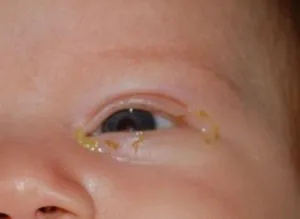
Many babies are born with a tear duct blockage and a high percentage of them will clear up with little or no treatment, however if your baby wakes up with crusty eyes that are hard to open it can be distressing for you and your baby.
Why does it happen?
The eye has tears, a watery film that contains good bacteria. Blinking wipes a thin film of tears over the eyeball to the nasal side of the eye and then down the chute of the naso- lacrimal duct and into the nose where they evaporate.
If the duct is blocked either mechanically by squashing of your baby’s face in utero or at birth or if the duct has not formed the tears do not drain. That is when you can see matting or sore cheeks when the tears drain down the face instead. The reason the eye mats is because the tears themselves have helpful bacteria but when the washing of the eye is inefficient then the bacteria pools giving a yellow matted look and there can be a discharge from the inside of the eye and on the eyelashes. This does need however to be distinguished from conjunctivitis. Conjunctivitis can make the white of the eye red whereas a blocked tear duct does not. However, if you are unsure you should seek medical clarification as conjunctivitis may need treating with antibiotics.
The condition can be due to:
- Infection
- Inflammation
- Injury
- Trauma including on the face at birth from a face presentation or the use of forceps.
- Conjunctivitis
- Abnormal development of skull and face including lack of a naso-lacrimal duct (about 6% of cases)
What you can do to help:
- Clear away the matting with cooled boiled water or breast milk
- With clean washed finger stroke from just under the inside corner of the eye down the side of the nose on the cheek side, stretching the skin a little to see if this will aid drainage.
- Check with a medical person to see if your baby has conjunctivitis. If your baby is older than 3 months old and it suddenly happens with no trauma, then it is more likely to be conjunctivitis.
- Check in with paediatric osteopath to se if they can treat any strains in your baby’s face that are causing a blockage of the naso-lacrimal duct.


